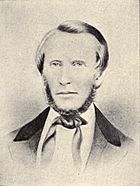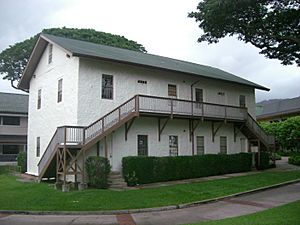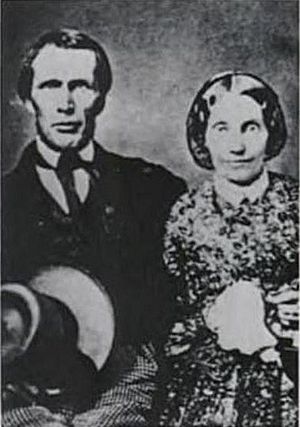William Harrison Rice facts for kids
Quick facts for kids
William Harrison Rice
|
|
|---|---|

Circa 1856
|
|
| Born | October 12, 1813 |
| Died | May 27, 1862 (aged 48) |
| Occupation | Teacher, Planter |
| Known for | Punahou School |
| Spouse(s) | Mary Sophia Hyde |
| Children | William Hyde Rice Anna Charlotte Rice Three others |

William Harrison Rice (born October 12, 1813 – died May 26, 1862) was an American teacher and missionary. He moved to the Hawaiian Islands and later became important in managing one of the first sugarcane farms there.
Contents
Early Life and Family
William Harrison Rice was born on October 12, 1813, in Oswego, New York. This town is located right on the shore of Lake Ontario. His parents were Joseph and Sally Rice.
On September 29, 1840, William married Mary Sophia Hyde. Mary was born on October 11, 1816. Her father, Jabez Backus Hyde, was a missionary to the Seneca people in western New York. Mary's mother was Jerusha Aiken Hyde. Her father even performed their wedding ceremony!
Journey to Hawaii
The Rices joined the ninth group of missionaries traveling to Hawaii. They sailed with the American Board of Commissioners for Foreign Missions. Their ship, the Gloucester, left Boston on November 14, 1840. They finally arrived in Honolulu on May 21, 1841. Other missionaries on this trip included John Davis Paris, Elias Bond, and Daniel Dole.
The Rice and Paris families had planned to go to the Oregon Territory. However, they heard about problems with Native Americans at the Whitman Mission. Because of this, they decided to stay in Hawaii instead.
First Mission Station
After learning the Hawaiian language, the Rices were sent to a remote mission station. This was the Wānanalua mission in the Hana district. Hana is on the eastern coast of the island of Maui.
Reverend Daniel Conde had started the station in 1838. At first, services were held in a traditional Hawaiian building made of thatch. Starting in 1842, the native Hawaiians helped build a new stone church. This stone building is still standing today!
Teaching at Punahou School
In 1844, the Rice family moved to Honolulu. They became the first non-religious teachers at Punahou School. Daniel Dole had founded this school two years earlier.
One of William's first jobs was to build a house for his family. This house also had rooms for students who lived at the school. It became known as "Rice Hall."
From 1848 to 1851, William also oversaw the building of another important school building. This building is now called "Old School Hall." A lot of the work was done by the students themselves!
Managing a Sugarcane Plantation
In 1854, the Rices left Punahou School. They moved to the island of Kauaʻi. There, William became the manager of the Līhuʻe Plantation. This plantation was owned by Henry A. Peirce and William Little Lee.
The plantation had faced tough times, including bad storms and a drought. So, William's pay included shares in the company. He also got a house called Koamalu, which means "shade of the Acacia koa tree."
Building an Irrigation System
From 1856 to 1857, William Rice designed and managed a big project. He built the very first irrigation system for sugarcane in the Hawaiian Islands!
This system brought water from the wetter areas of Kilohana Crater. It diverted the Hanamāʻulu Stream to help with the problem of uneven rainfall. It started as a simple ditch, much like the smaller systems ancient Hawaiians had used. Over time, it grew to include flumes (water channels) and tunnels.
Later Life and Legacy
William Rice took a short trip to California in 1861. Sadly, he died from tuberculosis in Līhuʻe, Kauaʻi, on May 27, 1862. His wife, Mary, lived much longer, until May 25, 1911. She continued to support good causes.
William did not live to see how valuable the plantation shares would become. The demand for sugar grew a lot because of the American Civil War and the Reciprocity Treaty of 1875.
In 1907, the first Rice Hall at Punahou School was taken down. A new dormitory, also named for the family, was built in its place. This second building was later removed in 1950. Today, the main open area of the campus is called Rice Field.
William and Mary's Children
The Rices had five children:
- Hannah Maria Rice was born in Hana on February 17, 1842. In 1861, she married Paul Isenberg from Germany. She passed away on April 7, 1867. Paul Isenberg (1837–1903) took over managing the plantation in 1862.
- Emily Dole Rice was born on May 10, 1844. She married George de la Vergne, a judge from Honolulu, in 1867. Emily died on June 13, 1911.
- Their son, William Hyde Rice, was born on July 23, 1846. He became a politician and served as the last Governor of Kauai.
- Mary Sophia Rice was born on January 7, 1849, and died on September 5, 1870.
- Their daughter, Anna Charlotte Rice, was born on September 5, 1853. She married businessman Charles Montague Cooke. Anna later founded the Honolulu Museum of Art. She died on August 8, 1934.
Anna and Charles's son was the banker and politician Clarence Hyde Cooke (1876–1944). One of their great-grandsons is judge Alan Cooke Kay (born 1932). Other family members include scientist Charles Montague Cooke, Jr. (1874–1948), musician Francis Judd Cooke (1910–1995), and baseball player Steve Cooke.
The simple irrigation system William built grew much larger over the years. Other places in the islands copied his idea, including a project by Henry Perrine Baldwin. Baldwin's daughter, Charlotte, married William's grandson, Harold Waterhouse Rice, in 1907. By 1922, William Harrison Rice had 66 known living descendants.
Images for kids



